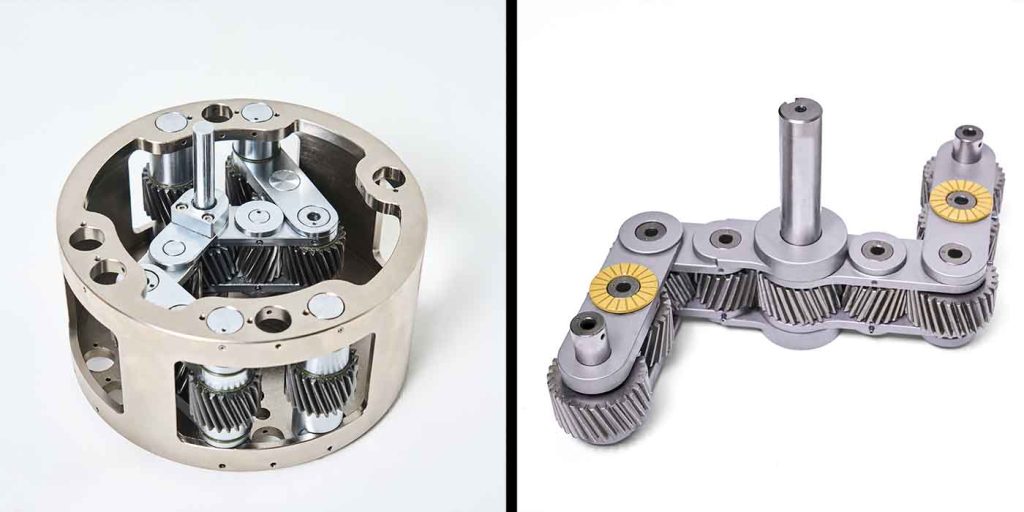
During a “Uni Wheel Tech Day” event held in Seoul earlier today, Hyundai Motor and Kia Corporation presented a potentially game-changing approach to the design of an EV’s drivetrain. The Universal Wheel Drive system, or “Uni Wheel” for short, moves main components to the wheel hub, creating additional space in a given vehicle’s interior. Learn more in the video below.
While the global mobility market slowly but surely transitions into the bright, all-electric future, many of the design techniques and necessary mechanical components have changed and in many cases, been minimized. One key component in ICE vehicles, however, has remained relatively the same in the leap to EVs – the drivetrain.
Power created in internal combustion engine vehicles is transmitted from the engine through the transmission, then out toward the wheels via drive shafts and constant velocity (CV) joints. In EVs, the engine and transmission are replaced by a motor and reduction gear, but the method of power transmission to the wheels is still the same.
Electric motors are more compact and when combined with flat EV platforms, have created a lot more interior space within the same vehicle footprint compared to ICE cars. However, those motor(s) still take up space in the front and/or rear of an EV.
Today, Hyundai and Kia have introduced a new drive system solution that can create even more platform space, while maintaining the efficiency necessary for effective EV range. We’ll explain it as best we can, but Hyundai Motor’s images and video below are an excellent guide as well. Meet Hyundai and Kia’s new Uni Wheel system.
Hyundai’s Uni Wheel system frees up more interior space
Kia and Hyundai shared details of the new Uni Wheel technology in a press release following its Tech Day event held in South Korea earlier today. Described by its makers as a “paradigm-shifting vehicle drive system,” the Uni Wheel uniquely moves the main drive system components to the vacant space within an EVs wheel hub.
We’ve seen other passenger EV developers like Lordstown Motors try in-hub motors and fail (and go bankrupt), but have also seen startups specializing in commercial EV technologies like REE Automotive develop a similar approach with its proprietary REEcorners.
Hyundai has taken a similar yet unique approach with the Uni Wheel system that utilizes a special planetary gear configuration consisting of a sun gear in the center, four pinion gears on each side, and a ring gear surrounding everything (see second image above).
Traditional ICE vehicles utilize CV joints, but by moving them closer to the wheels requires a short drive train length and as a result, a decrease in efficiency and durability – especially over bumpy terrain. Hyundai and Kia’s Uni Wheel system, on the other hand, can transmit power with almost zero changes to efficiency, regardless of wheel movement. Per Kia:
Power generated by the motor is transmitted to the sun gear, which in turn engages the pinion gears to rotate the ring gear. This is connected to the wheel to drive the vehicle. Uni Wheel’s pinion gears are connected to each other to form two linkages, and this multi-link mechanism enables Uni Wheel’s multi-axis movement to allow a wide range of suspension articulation.
The result is more platform space and in return, more room within an EV’s interior, including cargo space plus roomier trunks and frunks. The technology also opens the door to a wider design opportunity for non-conventional seating configurations within the cabin, which could prove fruitful as we continue to develop and integrate more autonomous driving technologies into our vehicles.
Still following? I truthfully didn’t quite grasp exactly how the Uni Wheel technology works until I watched the full video posted by Hyundai Motor Group you can view below. Sometimes, it’s best to leave it to the experts, especially when visuals are involved.
Looking ahead, Hyundai and Kia say they plan to continue to perfect the Uni Wheel system so that future customers can experience mobility in a “completely different and new way.” When we see this system integrated into an actual EV remains uncertain at this point, but Kia and Hyundai Motor state they have already applied for and registered eight patents related to the technology in South Korea, the US, and Europe. Learn more below:
Author: Scooter Doll
Source: Electrek







Top comment by Clint
Liked by 11 people
It took me until the end of the article to wrap my mind around what this is. It’s not a hub motor, it’s a replacement for CV shafts. The shafts have to be a minimum length in order to allow for proper suspension articulation. The minimum length places the motors further into the center of the vehicle. This solution appears to put the motor directly behind the hub, as close to the outside of the vehicle as possible. It’s technically not a hub motor though, since the motor is still sprung weight (mounted to the frame)
View all comments